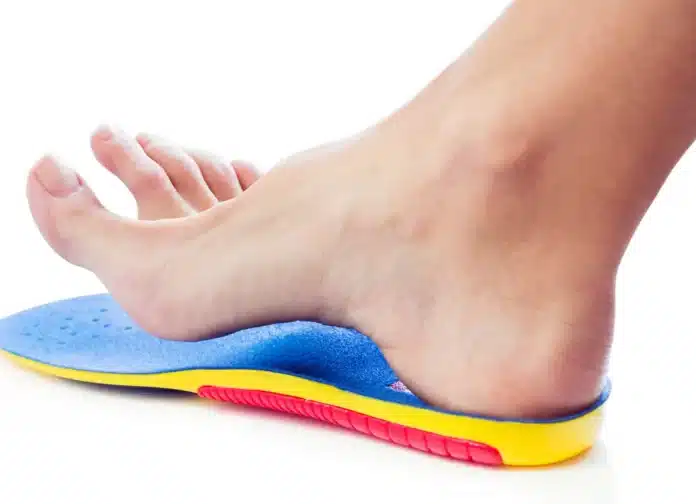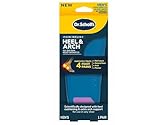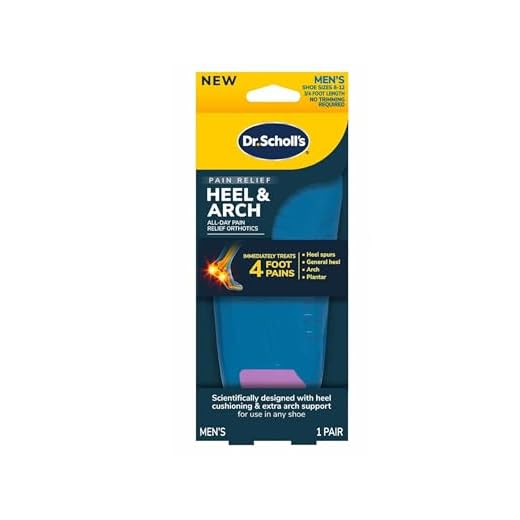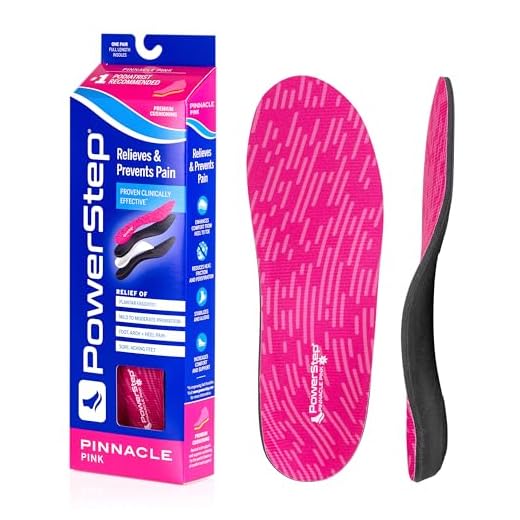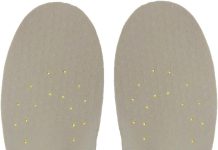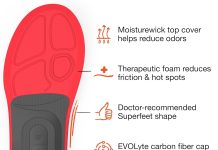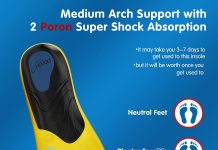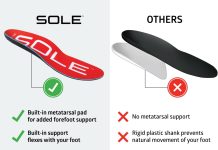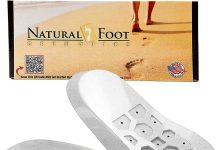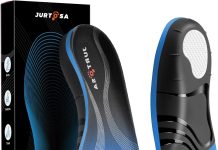Heel spurs can be incredibly painful and take a toll on your day-to-day life. It’s hard to focus on anything else with the pain from heel spurs, but there is hope – insoles!
Insoles are an innovative way to manage and even reduce the symptoms of heel spurs. In this article, we will explore how insoles for people with heel spurs work and what benefits they offer.
Do you suffer from frequent heel pain due to a spur? Are you looking for a new method of managing it? If so, then insoles could be precisely what you need.
They provide cushioning in all the right places while simultaneously providing support where needed most. Beyond just reducing the discomfort associated with heel spurs, insoles also help improve posture and stability and lessen fatigue throughout the day.
Insoles have become increasingly popular among those who suffer from chronic foot pains such as plantar fasciitis or heel spurs; however, many don’t understand how they work or why they are beneficial.
Read on to learn more about insoles and how they can help relieve your suffering caused by a heel spur once and for all!
What Is Heel Spur?
What is Heel Spur? A heel spur is an abnormal growth of bone in the heel area that can cause sharp pain and discomfort.
It’s typically caused by wearing shoes with poor support or from activities like running or jumping which put stress on the feet. The condition may also be associated with plantar fasciitis, Achilles tendonitis, and arthritis.
Heel spur causes vary, but they are most often due to repetitive trauma that leads to a buildup of calcium deposits in the heel area.
This can lead to inflammation and irritation of surrounding soft tissue structures resulting in extreme pain when standing for long periods or walking around. Overpronation (when your foot rolls inward too much) can also contribute to this problem as it puts extra strain on the heels.
If you suspect a heel spur, you must visit your physician for diagnosis and treatment options.
Your doctor will likely ask about your medical history, medications, and previous injuries before performing a physical exam to check for signs of tenderness or swelling in the affected area. An X-ray might also be taken so your doctor can see if any visible bony spurs are present within the heel.
Treatment for heel spurs depends on severity but may include rest, ice therapy, stretching exercises, orthotics (customized shoe inserts), corticosteroid injections, anti-inflammatory medications, or surgery if necessary. In some cases, lifestyle changes such as switching up footwear choices may help reduce symptoms associated with this condition.
Causes Of Heel Spurs
Heel spurs commonly cause foot pain, but what causes them? There are several potential causes for the development of heel spurs. One possible cause is repetitive stress injuries to the feet, such as those from running or jumping.
This type of injury can lead to inflammation and micro-tearing of tendons and ligaments in the feet, which can eventually result in the formation of heel spurs.
Another potential cause is improper footwear. Shoes that don’t provide adequate arch support or cushioning can put extra strain on the feet, making it more likely for heel spurs to develop over time.
In addition, if you suffer from conditions like arthritis or gout, these can also contribute to the developing of painful heel spurs.
These conditions affect how your body processes certain minerals; if they become imbalanced, they could accumulate calcium phosphate crystals near your heels, resulting in spur formation.
Lastly, people with flat feet or high arches may be more prone to experiencing issues with their feet due to an altered gait caused by their condition, which can ultimately lead to heel spurs forming.
To reduce your risk of developing troublesome foot spurs, it’s essential to help prevent further damage, such as using proper shoes when exercising, stretching before physical activity, and taking breaks during activities requiring standing for long periods.
Regular visits with a podiatrist should also be done so they can check your feet for signs of problems early on and treat them accordingly before they worsen into something more extensive, like a heel spur attack.
Symptoms Of Heel Spurs
Heel spurs commonly cause heel pain, and many people experience discomfort. Symptoms can range from mild to severe, depending on the severity of the condition.
The most common symptom is intense heel spur pain, usually with walking or standing for extended periods. Other symptoms may include heel spur swelling, inflammation, and tenderness in the area around the spur. Additionally, some individuals may experience difficulty flexing their feet due to restricted movement caused by the spur.
To minimize symptoms associated with heel spurs, those affected should avoid activities that strain their feet, such as running or jumping. It’s important to wear supportive shoes that provide cushioning and arch support to alleviate the pressure placed on the heels during activity.
Physical therapy or orthotics may be prescribed for more severe cases to help reduce stress on areas prone to developing bone spurs. In addition, over-the-counter medications such as ibuprofen can be taken to reduce inflammation and lessen any accompanying pain.
Taking care of one’s feet is essential when dealing with a condition like heel spurs. Hence, seeking medical advice is essential if symptoms persist or start interfering with daily activities. Early diagnosis and treatment can prevent further damage and help relieve discomfort caused by this painful condition.
Diagnosis & Treatment Options
If you have heel pain, it’s essential to diagnose the cause.
Heel spurs commonly cause chronic heel pain and can be diagnosed with imaging tests such as X-rays or ultrasounds. Your doctor may also ask about your medical history and any activities contributing to your condition.
Once you’ve been diagnosed with heel spurs, several treatment options are available. Surgery is rarely needed but may be recommended if other treatment fails to provide relief after six months or more. Non-surgical treatments include stretching exercises to help reduce tension in the Achilles tendon, orthotics for extra support, over-the-counter medications for inflammation and pain relief, physical therapy, steroid injections, and shockwave therapy.
Working closely with your doctor before deciding on a spur treatment plan is essential to determine which option best suits your needs.
They will review all possible treatments based on the severity and duration of the injury as well as how much improvement has already occurred through non-surgical methods.
With the correct diagnosis and treatment plan, people with heel spurs should expect gradual improvements in their symptoms over time.
Benefits Of Insoles For Heel Spurs
Using insoles to treat heel spurs can have numerous benefits. They provide pain relief, increased mobility, and support the foot arch. This helps reduce inflammation and discomfort associated with this condition.
Insoles are designed to cushion the feet while providing extra stability for walking or running. Supporting the foot arch eliminates excessive pressure on the heel spur, significantly reducing pain and inflammation. The added shock absorption prevents further injury from occurring in the affected area.
Furthermore, they help reduce strain on other body parts, such as ankles, knees, hips, and back by evenly distributing weight across these areas when standing or walking.
By using insoles specifically designed for people suffering from heel spurs, there is potential for long-term relief from uncomfortable symptoms like soreness and stiffness in calves and feet muscles.
In addition to reducing redness and swelling around the affected area, proper arch support provided by insoles may also slow the formation of new bone deposits that develop due to calcium buildup over time.
Additionally, wearing insoles daily will help improve posture since it encourages a better stance throughout activities like standing or walking on hard surfaces all day.
Regularly using quality insoles explicitly crafted for those who suffer from heel spurs, individuals can find significant relief from their symptoms while promoting good physical health overall.
Types Of Insoles For Heel Spurs
Choosing the correct type of insole is essential when dealing with heel spurs. Orthotic insoles are a popular choice as they provide support and cushioning for the feet while helping to reduce pain. They can also be customized according to individual needs and come in various materials such as leather or foam.
Shock-absorbing insoles may also help those suffering from heel spurs. These insoles are designed to absorb shocks caused by walking or running on hard surfaces and help prevent further heel damage. Gel-filled insoles can also provide extra cushioning and comfort when standing or walking for extended periods.
To find the best insole for heel spurs, it is essential to consult with a doctor or orthopedic specialist first, as each person’s needs differ depending on their condition and lifestyle habits. That said, finding an appropriate insole that will reduce discomfort associated with this condition and improve overall foot health is possible.
How To Choose The Right Insole For Heel Spurs
Choosing the right pair is essential for insoles to relieve heel spurs.
The best insoles for heel spurs are explicitly designed for that purpose and can help reduce pain and improve mobility. Here’s how to select an insole that is most suitable for your individual needs:
First, consider the type of arch support you need. If you have high arches, look for an insole with firmer cushioning or extra padding.
For people with flat feet, look for a softer foam insole with more flexibility. When selecting the correct insole, consider existing foot conditions, such as plantar fasciitis.
Next, assess the level of shock absorption needed. Heel spur sufferers often benefit from additional cushioning around their heels to absorb impact while walking or running. Look for cushioned inserts made from materials like memory foam which will offer maximum comfort and protection during activities.
Additionally, if you plan on wearing your shoes all day, opt for a lightweight yet supportive insert that won’t add unnecessary bulk inside your shoe but still offers adequate support and stability.
Finally, ensure your chosen insole fits appropriately within your footwear size and width measurements – this ensures optimal comfort and effectiveness of the treatment over time.
A snug fit is essential; if it feels too tight or loose, find an alternative model that suits your needs without compromising quality or performance levels.
With these tips, you can pick the perfect pair of insoles tailored to treat heel spurs and achieve lasting relief from pain and discomfort!
Potential Complications From Using Insoles For Heel Spurs
Although insoles are generally considered safe for people with heel spurs, there may be some potential complications to consider. The most common side effect of using an insole is discomfort or pain at the point where the spur is located.
This can happen if the insole does not fit correctly and irritates the area around the spur. Additionally, wearing a non-customized insole can increase your risk of foot injury due to a lack of support and cushioning.
Another potential complication is that overuse of inserts could reduce pain relief from heel spurs.
Using too much arch support or cushioning could cause increased pressure on your feet, leading to further irritation and inflammation around the spur. Finding an insole that provides just enough support without becoming uncomfortable when worn for extended periods is essential.
Finally, there’s always a chance that an off-the-shelf insert won’t provide adequate protection against additional damage caused by heel spurs and other foot injuries.
Customizing your insole will give you more control over its shape, size, design, and materials, ensuring better safety than generic store-bought options.
Taking these steps before buying any insole for heel spurs can help ensure long-term comfort and prevent future problems related to their use.
Frequently Asked Questions
Are Insoles Recommended For All Types Of Heel Spurs?
Are insoles recommended for all types of heel spurs? This is an important question, as the wrong type of insole can worsen matters instead of providing relief.
Heel spurs are a common condition that causes pain and discomfort, so it’s essential to determine which type of insole will provide the best support.
When looking at different insole types, there are several factors to consider. For instance, cushioning insoles can help absorb shock, while orthotic insoles offer more arch support.
The cushioning or degree of arch support depends on individual preferences, activity levels, and severity of heel spurs. Some materials, such as gel or foam, might be better suited for certain activities, like leather or plastic.
It’s also important to note that although insoles may provide pain relief from heel spurs, they won’t necessarily cure them altogether. In many cases, additional treatments such as stretching exercises or physical therapy may be necessary for long-term symptom management.
Ultimately when deciding whether insoles are right for you and your particular case of heel spurs, it’s wise to consult with a doctor or specialist who can recommend specific options based on your individual needs.
How Long Does It Take For An Insole To Provide Relief For Heel Spurs?
Heel spurs can be a painful condition caused by calcium deposits that form on the heel bone. Finding relief from this pain can be difficult, but one option is using an insole to provide cushion and support.
When considering insoles as a treatment option for heel spurs, it’s essential to consider how long they may take to provide relief.
The duration of insole relief depends significantly on the severity of the heel spur and what type of insole is used. Most insoles are designed to relieve some immediate discomfort associated with heel spurs, providing temporary pain relief within days or weeks after use.
However, if someone has severe heel spurs, more time may be needed before significant pain reduction is achieved. Additionally, other factors like activity level and lifestyle choices also impact how quickly an individual will feel relief from their insoles.
To get the most out of an insole for your heel spurs, it’s best to look at them as part of a larger plan for managing your condition instead of expecting overnight results.
With consistent wear over several months, many people find lasting improvement in their symptoms with regular use, even when dealing with chronic or persistent pain due to heel spurs.
Taking steps towards better health, such as stretching regularly and choosing proper footwear for activities, can help maximize the effectiveness of insoles so you can enjoy longer-term pain relief.
Are There Any Side Effects To Using Insoles For Heel Spurs?
When it comes to treating heel pain, insoles are a popular option. But before investing in a pair of insoles for your footwear, you may be wondering whether there are any side effects associated with their use.
Generally speaking, the answer is no; however, understanding potential symptoms and how to avoid them can help ensure that treatment remains comfortable and practical.
In terms of comfort, most people find that cushioning provided by an insole helps reduce discomfort caused by heel spurs. However, if the wrong type of insole is used or they are not fitted properly, it could lead to minor issues like blisters or soreness on the feet.
To minimize such problems, purchase insoles specifically designed for your shoe size and condition and have them professionally fitted by a specialist, or at least try them out while wearing socks first.
Finally, it’s also important to note that even with proper care and attention are given to selecting and fitting the right insoles for your footwear, certain activities still might cause strain on your feet which could result in discomfort or pain due to a heel spur being aggravated.
In these cases, it’s best to take regular breaks from physical activity and adjust your gait pattern accordingly not to aggravate the issue further.
Considering both comfort factors and potential risks when using insoles for treating heel spurs, you can maximize their effectiveness while avoiding unwanted side effects.
Is It Possible To Prevent Heel Spurs With Insoles?
Shoe insoles have long been a popular choice to help with foot pain and provide additional cushioning, especially for those who stand or walk often. But are they effective when it comes to preventing heel spurs?
To answer this question, we need to look at the role of preventive insoles in heel spur prevention. Heel spurs can be caused by several factors, including wearing ill-fitting shoes and prolonged standing on hard surfaces.
Insoles can undoubtedly be essential in reducing the risk of developing heel spurs by providing additional cushioning and support that helps prevent overstretching of tendons and ligaments around the heel area.
Using insoles designed explicitly for preventing heel spurs may also help reduce inflammation associated with conditions such as plantar fasciitis.
So while there is no guarantee that insoles will completely prevent heel spurs, they offer some clear benefits when it comes to reducing the risk of developing them and helping manage symptoms if you already have one.
Ultimately, finding the right combination of supportive footwear and preventive insoles could make all the difference in protecting your feet from painful issues like this.
Can Insoles Worsen The Condition Of Heel Spurs?
Can insoles worsen the condition of heel spurs? Considering this question before investing in foot support is essential, as it could worsen the situation.
While there are many potential benefits of using an insole for a person suffering from heel spurs, these should be weighed against the risks that may cause further discomfort or even increase existing issues.
People with heel spurs can benefit from wearing an insole because it provides cushioning and shock absorption, which can help reduce pain when walking or standing. However, it is also possible that wearing specific insoles might worsen the condition depending on how tight they fit and what kind of material they are made of.
Long-term use of an ill-fitting insole or one made from stiff materials could put extra pressure on parts of your feet, leading to increased inflammation and swelling around the area affected by heel spurs.
Therefore, it is best to consult with experts such as podiatrists before purchasing insoles designed for treating heel spurs.
This way, you can get personalized advice tailored to your needs rather than relying solely on trial-and-error methods when buying off-the-shelf products.
Here are five tips for selecting an appropriate insole:
* Make sure to measure your foot correctly so that you purchase an insole that fits properly
* Look for shoes with removable soles so that you can switch them out if needed
* Choose soft but supportive materials such as foam or neoprene
* Select inserts designed explicitly to reduce discomfort caused by heel spurs
* Avoid rigid materials like plastic or metal as they will not provide adequate cushioning
Ultimately, insoles can play a role in helping people manage their heel spur symptoms if chosen carefully; however, using the wrong size or type may exacerbate problems instead of improving them.
Therefore, it’s essential to research and takes professional advice before investing in any footwear support system.
Conclusion
In conclusion, insoles are an effective treatment for heel spurs. They provide fast relief and can help prevent the condition from worsening. However, it’s important to remember that not all heel spurs respond well to insole therapy.
It’s best to consult with a podiatrist or orthopedist who can evaluate your particular type of heel spur and advise whether insoles are appropriate for you.
Awareness of any potential side effects while using insoles is also essential. For example, some people initially experience discomfort when wearing them, but this typically subsides after a few days as their feet adjust to the new support the insole provides.
Additionally, if you already suffer from other foot conditions, such as plantar fasciitis or bunions, it’s possible that wearing an insole could worsen those issues.
Insoles are an excellent option for treating heel spurs and providing quick pain relief. I highly recommend giving them a try! When used correctly and under the guidance of a medical professional, they can significantly reduce symptoms associated with heel spurs and even offer protection against recurrence.
Dr. Scholl’s HEEL Pain Relief Orthotics // Clinically Proven to Relieve Plantar Fasciitis, Heel Spurs and General Heel Aggravation (for Men's 8-12, also available for Women's 5-12)
(220+lbs) Plantar Fasciitis Strong Arch Support Insoles Inserts Men Women - Flat Feet - Orthotic Insoles High Arch for Arch Pain - Boot Work Shoe Insole - Heavy Duty Support Pain Relief (L, Black)
$23.99 in stock
Koxmak TPE Gel Heel Cup with Cushion for Heel Pain Relief/Heel Bone Spurs/All Day Heel Protection &Shock Absorbing 2 Pairs Women's (Size 4.5-12)
Dr. Foot Plantar Fasciitis Relief Inserts, Gel Heel Cups For Heel Spurs, Heel Pain, Arch Support or Ankle Pain, Foot Orthotic Insole Shock Absorption Heel Cushion Pads For Men and Women (Small, Black)
Superfeet GREEN - High Arch Orthotic Support - Cut-To-Fit Shoe Insoles - Men 9.5-11 / Women 10.5-12
$41.11 in stock
Powerstep Pinnacle Insoles - Shoe Inserts for Arch Support, Plantar Fasciitis, Pronation & Heel Pain Relief - Insoles for Women & Men for Feet Pain Relief - Podiatrist-Recommended Orthotics
Gel Heel Cups Plantar Fasciitis Inserts - Silicone Heel Cup Pads for Bone Spurs Pain Relief Protectors of Your Sore or Bruised Feet Best Insole Gels Treatment by Armstrong Amerika (Small)
$18.95 in stock

